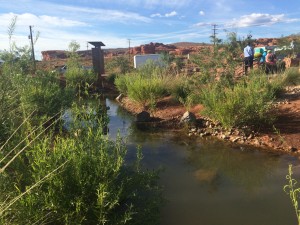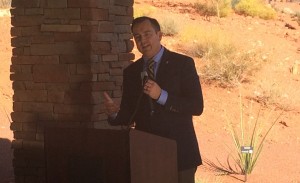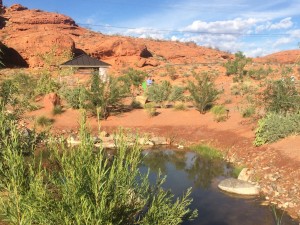ST. GEORGE – Though open to the public since May, the Red Hills Desert Garden had it’s official dedication Wednesday with fanfare and various officials and members of the public in attendance. The primary purpose of the garden is to spread education and awareness of landscape practices that conserve water, while also playing host to a handful of other attractions.
While people can read and talk about water conservation practices, the garden provides a place people can see it in action, said Ron Thompson, general manager of the Washington County Water Conservancy District.
“It’s more of a learning experience if you can see it, touch it, feel it,” Thompson said. “That’s what we hope this garden will allow people to do.”
Set between the Washington County Water Conservancy District’s office building and nearby Pioneer Park along Red Hills Parkway, the $3 million conservation garden covers 5 acres and features a landscape of over 5,000 low-water-use plants and a 1,150-foot meandering stream. (See ed. note.) Paths crisscross the site and move along and over the stream, and benches are situated under shade structures, offering visitors a place to sit and enjoy the desert scenery.

A part of the path leads into an artificial slot canyon covered in red faux rock that blends into the native landscape. At the end of the slot canyon is a viewing area where visitors can observe fish native to the Virgin River swimming in the stream.
The landscaping featured in the garden requires 77 percent less water than traditional landscapes, Thompson said.
The water district has been involved in water conversation education since the 1990s, Thompson said, adding that water consumption in the county has gone down 26 percent in the last decade.
The desert garden was created in partnership with the City of St. George and other agencies. The city owns the land the facility was built upon.
St. George Mayor Jon Pike was present at the dedication and said planning for the community’s future water needs was paramount.
In the last decade, the St. George metropolitan area grew at an average rate of 3.86 percent, Pike said. The national average during that time was 0.7 percent. The mayor also shared economic data that pointed to continuing growth, such an increase in local private business, a rise in residents personal incomes and wages, transient room tax intake and increasing use of the regional airport.
“This means we’re got to be proactive in our planning,” Pike said. “This is one of the reasons why we have this garden. We have got to make sure we plan. … Everything in our community depends on (a) safe, reliable water supply. … We’ve got to use it wisely.”
St. George already has a number of water conservation-related ordinances enacted that dictate the times people can water, a tiered-fee system that increases with the more water a person uses, conservation rebates and workshops, and other measures aimed at reducing water use, Pike said.

Also attending the dedication was Speaker of the Utah House Gregory Hughes, R-Draper, who shared his thoughts on the importance of water conservation and the garden.
By 2060, Hughes said, Utah’s population is expected to double, with the population of Washington County quadrupling by that time. Providing water to the residents of the state overall requires a long view that water officials in Washington County have demonstrated, he said.
“What’s happening here in Washington County – that policies are being put in place in terms of when you water, the rate changing if you use water (too much), the type of landscaping that is used that conserves water – all these best practices that are happening here need to be understood across the state of Utah,” Hughes said.
He continued, “I really believe this area of our state is leading by example and has the opportunity to teach and really instruct the rest of Utah how we treat a finite resource like water as valuable as it really is.”
As for the garden, Hughes said that if a knucklehead like him can appreciate the beauty of how a desert garden looks, others will as well.

People will visit the garden and see that you can have beautiful landscaping while also learning how to conserve water, something Hughes said he believes will be replicated throughout the community.
“You have conservation and an unmatched beauty that people will enjoy when they come here,” Hughes said.
Though the prime focus of the garden is water conservation, it also provides educational opportunities for learning about the fish that occupy the Virgin River, as they also now inhabit the artificial stream that runs through the garden.
Recreations of dinosaur tracks uncovered during the garden’s construction can also be found through the property.
Ed. note: Number of plants updated per information received from Washington County Water Conservancy District.
Click on photo to enlarge it, then use your left-right arrow keys to cycle through the gallery.

At the Red Hills Desert Garden, St. George, Utah , Oct. 7, 2015 | Photo by Mori Kessler, St. George News

At the Red Hills Desert Garden, St. George, Utah , Oct. 7, 2015 | Photo by Mori Kessler, St. George News

At the Red Hills Desert Garden, St. George, Utah , Oct. 7, 2015 | Photo by Mori Kessler, St. George News

At the Red Hills Desert Garden, St. George, Utah , Oct. 7, 2015 | Photo by Mori Kessler, St. George News

At the Red Hills Desert Garden, St. George, Utah , Oct. 7, 2015 | Photo by Mori Kessler, St. George News

At the Red Hills Desert Garden, St. George, Utah , Oct. 7, 2015 | Photo by Mori Kessler, St. George News

At the Red Hills Desert Garden, St. George, Utah , Oct. 7, 2015 | Photo by Mori Kessler, St. George News

Speaker of the Utah House Gregory Hughes speaking at the dedication for the Red Hills Desert Garden, St. George, Utah , Oct. 7, 2015 | Photo by Mori Kessler, St. George News

At the Red Hills Desert Garden, St. George, Utah , Oct. 7, 2015 | Photo by Mori Kessler, St. George News

At the Red Hills Desert Garden, St. George, Utah , Oct. 7, 2015 | Photo by Mori Kessler, St. George News
Related posts
- Red Hills Desert Garden opens to public; STGnews Videocast, Photo Gallery
- Water Conservancy District aims for spring opening of $1M Red Hills Desert Garden
- Red Hills Desert Garden showcases endangered species, promotes water conservatin
- Red Hills Desert Garden: Wildlife, resources, conservation; opening fall 2013
Email: [email protected]
Twitter: @MoriKessler
Copyright St. George News, SaintGeorgeUtah.com LLC, 2015, all rights reserved.

